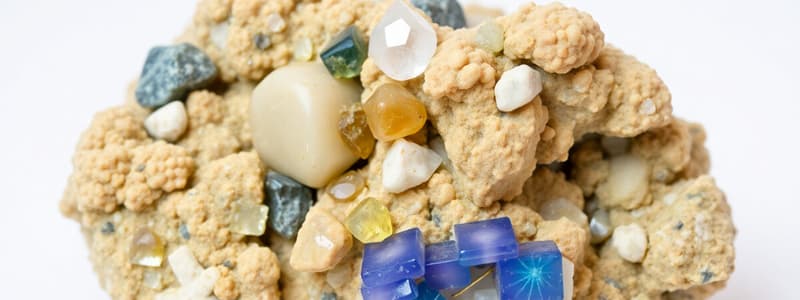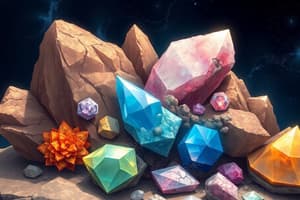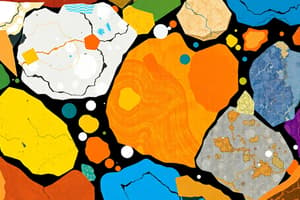Podcast
Questions and Answers
Which of the following is the best description of a rock?
Which of the following is the best description of a rock?
- An organic material formed from decaying plant matter.
- A pure substance found in nature.
- A type of mineral with a crystalline structure.
- A naturally occurring solid mixture of one or more minerals. (correct)
A mineral can consist of multiple types of particles bonded together.
A mineral can consist of multiple types of particles bonded together.
True (A)
What property of a mineral is assessed using the Mohs hardness scale?
What property of a mineral is assessed using the Mohs hardness scale?
Scratch resistance
The term referring to how easily light passes through a mineral is known as ______.
The term referring to how easily light passes through a mineral is known as ______.
Match the following rock types with their descriptions:
Match the following rock types with their descriptions:
Which of these processes leads to the formation of sedimentary rocks?
Which of these processes leads to the formation of sedimentary rocks?
Weathering only involves chemical processes that break down rocks.
Weathering only involves chemical processes that break down rocks.
What is the term for the process where sediments are glued together to form sedimentary rock?
What is the term for the process where sediments are glued together to form sedimentary rock?
The process by which sediments are transported from one place to another is called ______.
The process by which sediments are transported from one place to another is called ______.
Match the following terms with their respective definitions related to transparency:
Match the following terms with their respective definitions related to transparency:
Which type of rock is formed when intense heat and pressure alter an existing rock?
Which type of rock is formed when intense heat and pressure alter an existing rock?
Direct observation involves making inferences about a place without physically examining it.
Direct observation involves making inferences about a place without physically examining it.
What part of the Earth is the mantle located between?
What part of the Earth is the mantle located between?
The Earth's outer core is primarily composed of liquid ______ and nickel.
The Earth's outer core is primarily composed of liquid ______ and nickel.
Match each layer of the Earth with its characteristic:
Match each layer of the Earth with its characteristic:
Which type of crust is thinner and denser?
Which type of crust is thinner and denser?
The rock cycle describes the process by which rocks remain unchanged over time.
The rock cycle describes the process by which rocks remain unchanged over time.
What is the term for molten rock found inside the Earth's crust?
What is the term for molten rock found inside the Earth's crust?
When magma cools and hardens inside the Earth, it forms ______ igneous rock.
When magma cools and hardens inside the Earth, it forms ______ igneous rock.
Sedimentary rocks are the most likely place to find what?
Sedimentary rocks are the most likely place to find what?
Flashcards
What is a rock?
What is a rock?
A naturally occurring solid mixture of one or more minerals.
What is granite?
What is granite?
Igneous rock made from quartz, feldspar, and mica.
What is sandstone?
What is sandstone?
Sedimentary rock made from quartz and feldspar.
What is marble?
What is marble?
Signup and view all the flashcards
What is a mineral?
What is a mineral?
Signup and view all the flashcards
What are pure substances?
What are pure substances?
Signup and view all the flashcards
What is an element?
What is an element?
Signup and view all the flashcards
What is a compound?
What is a compound?
Signup and view all the flashcards
What is luster?
What is luster?
Signup and view all the flashcards
What is Mohs hardness scale?
What is Mohs hardness scale?
Signup and view all the flashcards
What is transparency?
What is transparency?
Signup and view all the flashcards
What is streak?
What is streak?
Signup and view all the flashcards
What are cleavage and fracture?
What are cleavage and fracture?
Signup and view all the flashcards
What is an igneous rock?
What is an igneous rock?
Signup and view all the flashcards
What is magma?
What is magma?
Signup and view all the flashcards
What is lava?
What is lava?
Signup and view all the flashcards
What is intrusive igneous rock?
What is intrusive igneous rock?
Signup and view all the flashcards
What is sedimentary rock?
What is sedimentary rock?
Signup and view all the flashcards
What is sediment?
What is sediment?
Signup and view all the flashcards
What is Cementation?
What is Cementation?
Signup and view all the flashcards
Study Notes
- Rocks are naturally occurring solid mixtures of minerals.
- Granite, an igneous rock, comprises quartz, feldspar, and mica.
- Sandstone, a sedimentary rock, is made up of quartz and feldspar.
- Marble, a metamorphic rock, consists of calcite and dolomite.
- Minerals are naturally occurring solids that are considered pure substances.
- Pure substances consist of only one type of particle and can be elements or compounds.
- Elements, like gold or silver, are minerals made of only one type of particle.
- Compounds, like quartz, sapphire, or emerald, are combinations of two or more types of particles bonded.
- Minerals are identified using lustre, hardness, transparency, streak test, cleavage or fracture, colour, and crystal formation.
Mineral Identification
- Colour is an easy but sometimes misleading way to identify minerals, since it can vary within the same mineral.
- Lustre describes the shininess of a mineral.
- The Mohs hardness scale measures a material's ability to scratch another, ranging from 1 (softest) to 10 (hardest).
- Transparency indicates how easily you can see through a mineral: transparent allows easy viewing, translucent allows partial viewing, and opaque prevents any viewing.
- Streak is the color of a mineral when scratched on a porcelain tile.
- Cleavage describes how a mineral breaks with flat surfaces and smooth edges, while fracture indicates breakage with rough surfaces and jagged edges.
- Crystal shape refers to the natural shape of a mineral in solid form.
Rock Types
- The three main categories of rocks are igneous, sedimentary, and metamorphic.
- Igneous rocks form from cooled and hardened liquid magma or lava.
- Magma is melted rock inside the Earth’s crust.
- Lava is melted rock on the Earth's surface.
- Intrusive igneous rocks, like granite, cool and harden inside the earth, allowing more time for crystal formation.
- Extrusive igneous rocks cool and harden on the Earth’s surface, resulting in less time for crystal formation.
- Igneous rocks were the first rocks on Earth, forming over 4.5 billion years ago.
- Below the earth's surface, 90% of the crust consists of igneous and metamorphic rocks.
- Sedimentary rocks are formed from compacted or cemented sediment.
- Sediment includes loose bits of broken-down rocks, minerals, and plant or animal remains like sand.
- Examples of sedimentary rocks are shale, sandstone, and conglomerate.
- Sediments pile up in layers called strata.
- Sedimentary rocks form through compaction from the weight and pressure of sediment layers.
Sedimentary Rock Formation
- Cementation occurs when sediments are glued together by another material to form sedimentary rock.
- Weathering creates sediment, while erosion transports it.
- Weathering breaks down rocks and minerals into smaller pieces called sediments.
- Mechanical weathering involves physical forces like gravity, water, wind, heat, and cold.
- Chemical weathering involves chemical reactions such as rusting or dissolving minerals in water.
- Biological weathering occurs when living things break down rocks or minerals mechanically or chemically.
- Erosion is the movement of sediments from one place to another by gravity, wind, or water.
- Sedimentary rocks form when sediments are compacted and cemented together.
- Weathering forms sediments, erosion transports sediments, and sediments are deposited in layers or strata.
- Sedimentary rocks are the most likely place to find fossils, comprising about 75% of the rocks on Earth's surface.
- Metamorphic rocks form when intense heat and pressure deep inside the Earth transform one rock type into another.
- Parent rock looks different from its newly formed metamorphic version.
- For example, the igneous rock granite becomes gneiss, and the sedimentary rock shale becomes slate.
- The metamorphic version of slate is schist
- Metamorphic rocks are typically formed deep underground and are not often exposed above ground.
- The rock cycle describes the natural process of rocks changing form over long periods.
Earth Layers and Observations
- Direct observations involve scientists physically visiting a site or taking samples.
- Indirect observations allow scientists to make inferences without being physically present or taking samples.
- The layers of the Earth, from outside to inside, are the oceanic crust, continental crust, upper mantle, lower mantle, outer core, and inner core.
- The crust, the Earth's outer layer, is made of solid rock and is divided into oceanic and continental crust.
- Continental crust is thicker (35-70 km) and less dense.
- Oceanic crust is thinner (5-10 km) but denser.
- Much of Earth’s crust is covered by water.
- The deepest hole on Earth extends 12 km into the continental crust.
- The mantle is the layer between the crust and the outer core, made of partially melted rock.
- Convection currents in the mantle are thought to move the crust.
- The mantle is the Earth’s largest layer by mass and volume, with an average temperature of 1000°C.
- The core, the Earth's inner part, has two main parts: the outer core and the inner core.
- The outer core is a liquid layer of iron and nickel with an average temperature of around 5000°C.
- Convection currents in the outer core are thought to create Earth's magnetic field.
- The inner core is a solid ball of iron and nickel.
- The inner core has an average temperature of around 5500°C, but remains solid due to immense pressure.
Studying That Suits You
Use AI to generate personalized quizzes and flashcards to suit your learning preferences.




